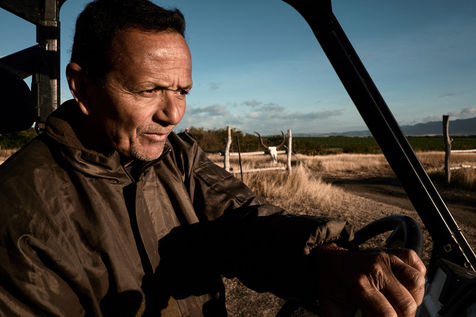Far Far West : La Brousse Calédonienne
--- Extraits d'un travail en cours de réalisation ---
Ces citoyens français du bout du monde ont plus de points communs avec des stockmen australiens qu'avec des éleveurs bovins de Normandie.
Les « Broussards » sont pourtant les premiers partisans du maintien de la Nouvelle-Calédonie dans la République.
La plupart d'entre eux sont des descendants de forçats du bagne ou de colons volontaires. Leurs ancêtres s'étaient reconstruit une vie à l'autre bout du monde au tournant du XXe siècle.
Ils exploitent de vastes propriétés agricoles, souvent gagnées sur des terres Kanak à l'époque de la colonisation.
Cette bande de terre de 450 km de long sur 70 km de large est leur seul pays. Le spectre de l'indépendance leur principale source d'inquiétude...
Lors de la dernière élection présidentielle, le Front National est arrivé en tête du second tour dans plusieurs communes de la côte Ouest et à Nouméa, la capitale.
Les « Broussards » ont largement voté pour la candidate la plus claire sur la question du maintien de la Nouvelle-Calédonie dans la France. Il s'agissait d'envoyer un signe fort à l'approche d'une échéance cruciale.
Car la collectivité devra se prononcer sur son accès à la pleine souveraineté d'ici la fin 2018. Cette étape marque la phase finale d'un processus de décolonisation engagé trente ans plus tôt avec les accords de Matignon-Oudinot.
De nombreux pouvoirs ont été transférés à ce territoire d'outre-mer devenu très autonome vis-à-vis de l'Etat. Les calédoniens seront prochainement consultés par référendum sur les dernières étapes prévues en 1998 par l'Accord de Nouméa. Il s'agit notamment du transfert des compétences régaliennes : la monnaie, la défense, la justice...
Le chemin emprunté depuis la fin des années 80 a permis d'apaiser les tensions entre les indépendantistes Kanak et les Calédoniens issus de la colonisation. Les « événements » sanglants qui ont opposé les deux factions à l'époque semblent bien loin.
Le paysage politique reste malgré tout fortement polarisé autour du rapport de force entre indépendantistes et loyalistes.
Derrière les postures des élus, où en sont réellement les communautés qui se faisaient face il y a trente ans ?
Que reste-t-il de l'idéal du « destin commun » prôné par l'Accord de Nouméa, lorsqu'on le confronte à la vie du quotidien ?
Le premier volet de ce travail - en cours de réalisation - brosse un portrait du « Far West calédonien ».
Far Far West : Caledonian Bush
These French citizens fromthe end of the world have more in common with Australian stockmen than with Normandy cattle breeders.
The Bushmen are, however, the first supporters of the maintenance of New Caledonia in the Republic.
Most of them are descendants of prison convicts or volunteer settlers. Their ancestors had rebuilt a life at the other end of the world at the turn of the 20th century.
They farm large agricultural holdings, often earned on Kanak lands during the period of colonization.
This strip of land 450 km long and 70 km wide is their only country. The specter of independence is their main source of concern ...
During the last French presidential election, the National Front party came first in the second round in several cities of the West Coast and Nouméa, the capital.
The Bushmen largely voted for the clearest candidate on the issue of maintaining New Caledonia in France. It was to send a strong signal as we approach a crucial deadline.
The community will have to decide on its access to full sovereignty by the end of 2018. This step marks the final phase of a process of decolonization initiated thirty years earlier with the Matignon-Oudinot agreements.
Many powers have been transferred to this overseas territory which has become very autonomous from the French State. Caledonians will soon be consulted by referendum on the final stages planned for 1998 by the Nouméa Agreement. These include the transfer of sovereign powers: money, defense, justice ...
The path taken since the end of the 80s helped to calm tensions between the Kanak separatists and the Caledonians from colonization. The bloody "events" between the two factions at the time seem far away.
The political landscape remains strongly polarized around the balance of power between separatists and loyalists.
Behind the postures of the politicians, what is the real state of mint of the communities that faced each other thirty years ago?
What remains of the ideal of the "common destiny" advocated by the Nouméa Agreement, when confronted with everyday life?
The first part of this work - in progress - paints a portrait of the "New Caledonian Far West".





















































































